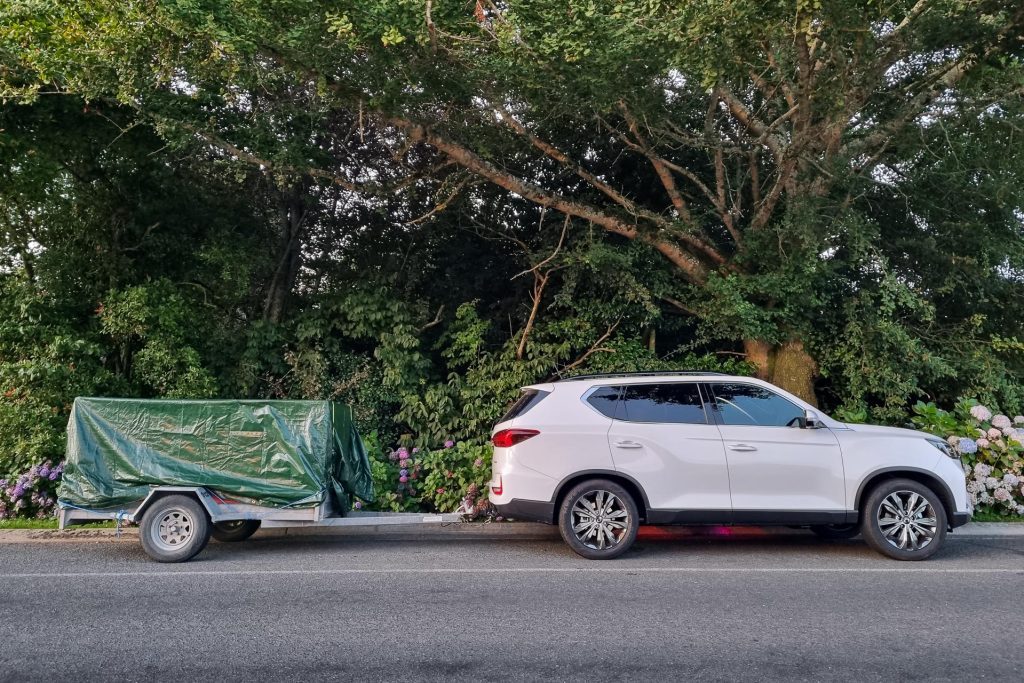It had been a while since we had been in the biggest SsangYong, the Rexton. The last time being the Rexton G4 in 2018 actually. It has been revised in the interim but is still the same sort of machine; a full-size, body-on-frame, 4×4 type of SUV.
And it proved rather useful, facilitating another family get away, trailer in tow with all the bits needed for a week at the beach.
The kids certainly enjoyed the room, liking the extra space afforded to them that a full-size SUV has to offer. The last few trips away have been in more compact SUVs.
And while they give adequate lodgings, things can get a bit fractious back there after a couple hours, so it’s a relief to have the extras of both legroom and cabin width on longer missions.

Rexton’s still a seven-seater too, with a couple of additional pews in the boot, handy for when you have extras, and for separating the factions when things get really tense.
We drive fewer of these full-chassis rigs now, most 4×4 nameplates having morphed into unibody crossovers generations ago. And this one is not the latest and greatest; we first drove this back in 2017, while an update was issued in 2021.
Compared with the newer Ford Everest, the ride quality isn’t as flash: the Rexton shimmies and squirms about at times.
This was especially noticeable on the rubbish surface of SH3 heading to New Plymouth as the progress got particularly bumpy in places.
That’s the main issue with the Rexton; the suspenders could be more resilient and it deserves better in that regard.

It’s still a likable machine, if you like these big SUVs. The 2.2-litre diesel fires this along just fine. Rexton is rated to tow 3.5 tonnes braked, so our little single-axle trailer was never going to test its worth; we didn’t know it was behind us most of the time.
Without the trailer in tow, highway cruising registers around 9L/100km, which rose toward the 11L/100km mark with it hitched up. Even trailering a modest load puts an extra demand on the reserves.
The revisions brought Rexton a new look to the front, that grille bigger, and the lights are new at each end.
Inside, it looks more premium too, haptic buttons for the ventilation (that make a dinky 80’s digital tone when pressed), a slightly bigger screen and a sawn off steering wheel (that feels a little odd when turning).
There’s a bit more snort from the diesel, output registering 148kW, with 441Nm from 1600-2600rpm. It’s processed by an eight-speed auto, an increase in cogs since we last drove it.

This is still programmed to slip through the gears, refinement preferred over racing, even in the Power mode.
The slick looking shift-by-wire mechanism is a little fiddly sometimes, requiring a deft touch, but you get the hang of it.
This has a light smattering of safety features; a lane departure warning (which we kept off) and AEB, though there’s no speed sign recognition, nor any active cruise.
Guess the upside is the fewer active safety features there are, the less they can continually bleat at you.
Some of the trip information is vexing – it’s unconventional shall we say – while the infotainment system has no buttons and its touchpoints are small.
It’s a fairly basic system, your phone needed for sat nav for instance. But this top SPR model gets nice things like heated and ventilated seats for more comfortable travel year round.

There’s a charge pad, USB-C plugs and decent storage. The cabin looks quality with its stitched dash pad, the quilted seats (comfortable too with good form and fit), ambient lighting at night, and the finishing is top rate, robust in an SUV way.
A few other good features include the surround view camera (also handy to line the tow bar up), the auto dipping headlights work as intended (and have an adjustable angle when towing), memory powered seats and the powered tailgate.
Hustling around town, the Rexon isn’t too cumbersome, the steering is light, just a tad slow, the turning circle manageable.
The turbo lag of the diesel isn’t such an issue, until you are in a hurry that is, and then you’re aware it takes that moment to come good. But then it hauls rather well above 1800rpm.
This has a conventional, part-time 4×4 system being rear drive in 2H with 4H and 4L available for slippery stuff. We even used the 4H setting to help rescue a stuck van. Handy things these SUVs.

And it’s good times for lovers of these big SUVs, now that the fees are gone, they are more affordable.
There are three Rexton variants, starting at $51,990 for the 2WD Teammate, though you’d find the money to buy the Sport 4WD given it’s $56,990.
This is the perhaps the pick of the range given it’s a big walk up to the SPR at $74,990, though those extras are always nice to have.
| Model | SsangYong Rexton SPR |
| Price | $74,990 |
| Engine | 2157cc, IL4, TDI |
| Power | 148kW @ 3800rpm |
| Torque | 441Nm @ 1600-2600rpm |
| Drivetrain | 8-speed auto, part-time AWD |
| Seats | 7 |
| Fuel Use | 8.9L/100km |
| C02 Output | 228g/km |
| Weight | 2233kg (claimed) |
This story first appeared in the March 2024 issue of NZ Autocar magazine.


